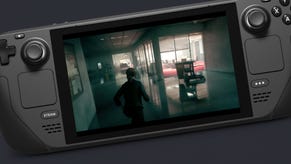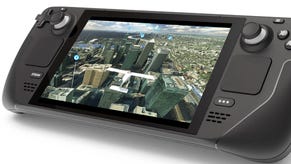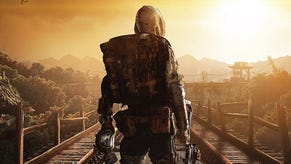Inside Metro Exodus Enhanced Edition: the first triple-A ray tracing game
DF tests the first major game release that demands an RT-capable graphics card.
This is it: the first triple-A game release that will only work on ray tracing capable graphics hardware. Metro Exodus Enhanced Edition takes the real-time RT global illumination of the initial PC release, improves it to an almost generational degree and hands in a game that actually runs faster than its predecessor. We're looking at the PC version today but you can see the groundwork laid here for the PlayStation 5 and Xbox Series renditions to follow later this year. Put simply, Metro Exodus was my number one title for 'best graphics 2019' and this enhanced edition takes an excellent game to the next level - and in fact, some might say it's our first look at the multi-platform game engines of tomorrow built from the ground-up with RT features in mind.
At the basic level, the enhanced edition takes the original 2019 version of Metro Exodus and revamps the engine to support ray traced global illumination along with a host of additional RT-based features. Further enhancements come from the additional of VRS - variable rate shading - along with Nvidia DLSS 2.1 AI upscaling, along with a temporal upscaling option best suited for AMD GPUs. The smart money suggests that this is the kind of scaling technology which we're likely to see deployed on the console versions (where both PS5 and Series X target 60fps output).
So, how has RT been improved? Put simply, the original Metro Exodus shipped with single bounce global illumination from the sun combined with ray traced ambient occlusion for all indoor areas. It looked great in comparison to the default real-time GI system that was already in place for the rasterised version of the game. However, the new RT system was added midway through development, so 4A Games had to essentially develop the game with two lighting schemes in mind. For the new Metro, the standard rasterised versions of each map - including all individually, artist-placed lights - are gone. The tricks, fake light sources and other legacy elements are replaced with a proper, real-time RT solution that 'just works'.
 Exclusive: Metro Exodus Enhanced Edition Analysis - The First Triple-A Game Built Around Ray Tracing
Exclusive: Metro Exodus Enhanced Edition Analysis - The First Triple-A Game Built Around Ray Tracing
The ray traced feature set is also revamped in terms of quality and overall functionality. Every shadow casting light in the game now contributes to global illumination, so all of those torches, flares, flash lights and glowy green mushrooms see their light bounce around the environment, radically improving the realism of the lighting. Metro Exodus 2019's RT GI would see light bounce just once - still impressive, but not a patch on the infinite light bounces now found in the Enhanced Edition. As you'll see in the video, the effect is totally transformative and like I said, it's a generational increase in fidelity compared to the first game. In fact, the boost to quality is almost akin to seeing real-time game graphics transform into something approaching a pre-rendered photorealistic scene.
More realistic light bounces generally results in scenes being more lavishly lit, so I was curious to see whether Metro Exodus had lost some atmosphere in its darkest, scariest interior moments. The truth is that those scenes are equally as atmospheric - it's just that solitary lights found in such scenes colour surrounding scenery more realistically, so shadows have colour instead of being pitch black near those light sources. And it's actually a treat to see characters wielding torches lighting up such areas with such fidelity - it adds to the immersion. I'll be saying this is a lot in this piece, but check out the video to see just how realistic and nuanced the effect is.
Another welcome addition to the ray tracing feature set are the ray traced emissive surfaces - so surfaces like flames or lights of various shapes and volumes give off light from their entire surface area, casting diffuse soft shadows around the environment. In the video, we have in-editor scenes showing off how this works generally, by moving a solid rectangular block of light around an enclosed environment, emphasising the correct propagation of light with little or no artefacting. It's a great demo for the tech, but the effect in-game is more subtle: like watching light bounce around the scene from the flames of a Molotov cocktail, for example. The flamethrower from the Two Colonels DLC is another great showcase and one you can play with for yourself right at the beginning of the story. The difference comes down to how the game offers much more realistic lighting and shadowing, produced automatically from even the most incidental of detail. In the video you'll see how candles evolve from basic light sources - limited in scope owing to performance limitations - to being able to cast their own shadows and without unwanted light leakage effects.

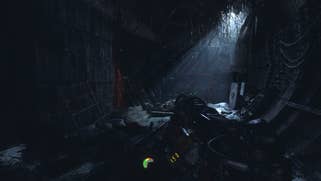
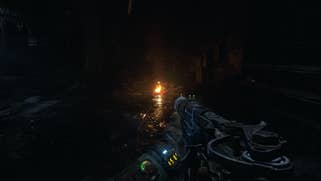
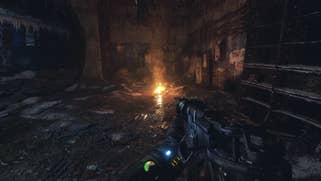




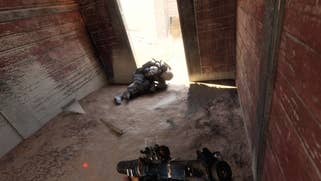

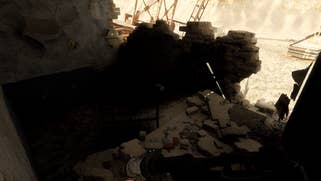

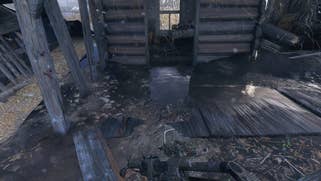

The new ray traced lighting also properly affects transparent surfaces and volumetric fog. Even particles are properly lit up from ray traced emissive lighting, while materials such as hair or eyes receive the correct level of bounce lighting, instead of using some approximation that could cause hair to 'glow' in the initial release. Ultimately, the infinite bounce RTGI produces ultra-realistic lighting conditions that almost look like offline rendering. Many games have static, off-line generated light maps where nothing moves but in this game it is actually real time, fully dynamic lighting that integrates beautifully with the time of day systems. Without a doubt, Metro Exodus Enhanced Edition's global illumination produces the best lighting I have ever witnessed in a video game.
Just when you think the list of upgrades is complete, 4A Games goes the extra mile, including ray traced reflections too. These apply everywhere but are readily visible on water, helping to clean up areas where screen-space reflections don't work so well. These RT reflections are similar to other titles you may have seen in some aspects but different in others. For one, they blend in screen-space information to enhance detail and to account for elements like particles or volumetric fog - elements that are difficult to integrate with RT. At the same time, these reflections use the same lower quality materials as the RT global illumination, so if you look at a reflection out of view, it is possible to see the materials are simplified. Likewise, the reflections do not include alpha-masked geometry like leaves on trees, so if you move the camera around in an area where there are lots of leaves, they will disappear out of the reflection when they're not on-screen. And lastly, the RT reflections do not seem to cover transparent surfaces that are not water, as far as I can tell, so there are some limitations.
With all these upgrades, inevitably here are a few compromises. Yes, the Enhanced Edition is phenomenal in many ways, but perfection is always a pursuit for the future. With the GI system, only the first light bounce is calculated in real-time, with other bounces the result of temporal accumulation, so you may see some 'lag' in the build-up of global illumination within the scene. When I deliberately set out to 'game' the system to amplify this effect, I noticed that it took around 20 full frames for all the bounces to accrue with the game running at 60fps. Very rarely, I encountered some glowing surfaces, while the RT effect runs with a relatively low sample count, so you can see some 'noise' sometimes in the lighting.
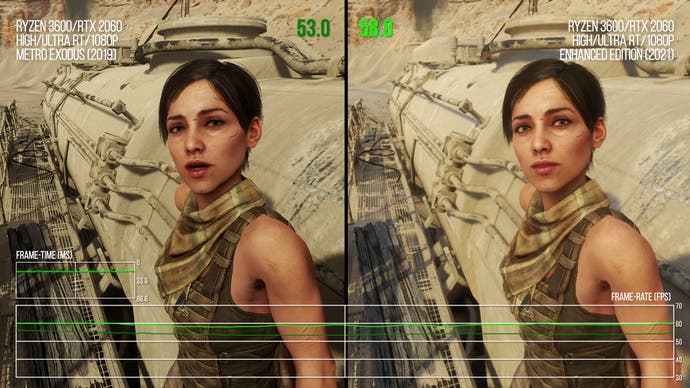
On the flipside though, here are more ray tracing settings in play for the user to tweak. The main ray tracing setting controls the internal resolution of the global illumination much like the 2019 version, but there is now a 'normal' setting below high that renders the GI at quarter of the internal resolution, whereas high is a checkerboarded rendition of your resolution, with ultra at native. Similar to the old game, high looks almost as good as ultra, with just a bit more noise in the final resolve. However, the normal setting shows a significant amount of extra noise. This setting seems tailored for those GPUs with less powerful ray tracing acceleration, and I wouldn't be surprised to see it appear in the upcoming console versions. But even with all of the extra improvements to RT, I noticed that an RTX 2060 ran the game just as well as the 2019 version - and usually a fair lick faster: anything up to 16 percent to the better, in fact, in my tests. However, testing with a Ryzen 5 3600, I did notice that the CPU requirement for the game has increased with a 13 per cent hit to performance. Typically though, you are far more likely to be limited by your GPU.
Variable rate shading (VRS) is also added, but this is a Tier 1 implementation primarily affecting forward rendered objects such as transparencies. 2x and 4x modes are available, degrading transparency quality. I would only recommend using the 2x mode and it should be disabled completely if you're using DLSS. While VRS has limited utility, DLSS is just amazing as usual - and as Metro Exodus shipped with the first iteration of DLSS back in 2019, it's fun to see the gigantic improvement the latest 2.1 version delivers. RT noise artefacting aside, even DLSS performance mode delivers an overall improved level of visual quality up against native resolution rendering at 4K, thanks to better realisation of sub-pixel detail and less shimmer.
For those without an RTX GPU, the game ships with a TAA upsampler, similar to the technology as found in Unreal Engine 4 or Insomniac games. You access this by moving down the shading slider. In a direct side by side with native it does an admirable job especially at the 0.7 value and above, so I definitely recommend using it on an AMD card. In comparison to DLSS 2.1 we see how important that machine learning component is, as even Nvidia's AI upscaled performance mode resolves more detail than the TAA alternative.
So, overall, Metro Exodus Enhanced Edition is simply brilliant. The game runs better than the original on the GPU side and looks a lot better due to new image quality options like temporal upsampling or DLSS 2.1. With the new RT features, the game looks fantastic, with some scenes at times approaching the lighting quality of offline rendering from a path tracer. 4A's success here is built on the daring ambition to be the first AAA game to mandate hardware accelerated ray tracing on the PC - so while the 2019 version of the game was a glimpse into the future, the Enhanced Edition is that future arriving - and it's simply brilliant. The update for PC users arrives on May 6th and it's free to existing owners of the game. Expect to see the newly enhanced console editions further on in the year and we'll be back soon with exclusive interviews with 4A Games going much deeper into the technical make-up of the new game.


